June 26, 2017 |
BITE: My Journal
Ishikawa: Let the Chef Invent!

King salmon with Japanese herbs snipped from a pot comes in Don Pham’s $125 omakase at Ishikawa.
I leave my house in a pleasant cloud of great expectations. I am meeting my friend Lauren Bloomberg, an ardent omakase companion, at chef Don Pham’s new Sushi Ishikawa. The two of us once spent $676 -- with no regrets -- for an evening’s tsunami of Pham’s piscatorial imaginings at O Ya.

We couldn’t have a better view of the chefs hands as he slices, torches and tweezes the sushi.
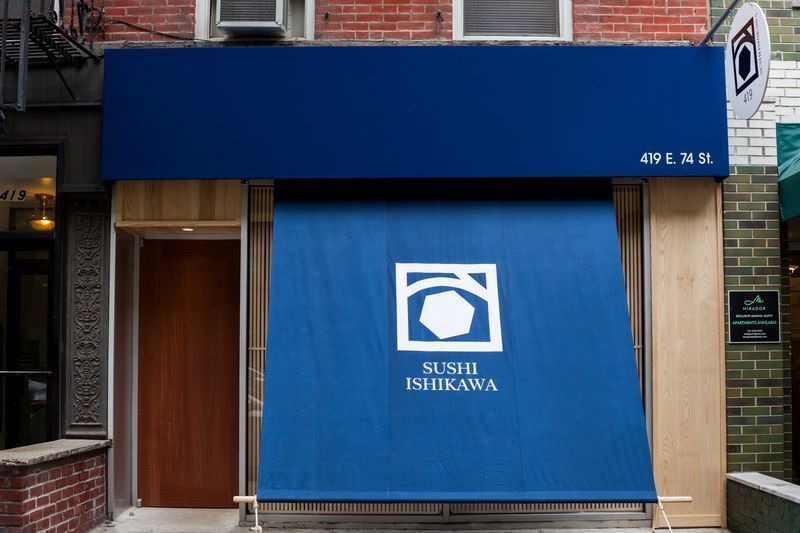
The exterior of Don Pham’s new Sushi Ishikawa on East 74th could not be more modest. No promises.

Expect shellacked brick, blonde wood, baskets hanging over light bulbs and orchids against the wall.
Now he has set himself up in a gently-priced little roost serving only omakase way east in the 70s with just 23 seats and room for 11 at the L-shaped blonde wooden bar. A large pot of white orchids sits on the counter behind the duo of sushi makers. Latecomers and parties of four seem content at the few tables against the lacquered brick wall. A trio of baskets suspended above filter light from bare bulbs.

A collection of cute little chockstick holders line the counter. Lauren gets a plump lady. I have a panda.

Eleven sets at the counter where the chef will deliver your omakase parade to terra cotta platters.
For a few minutes we are the only two at the bar, amused by the cute little china chopsticks holders, and then Pham and his sous call out “Irasshaimase!” the traditional welcome. Three women claim the seats next to us at the bottom of the “L.” We surround our hero as he wipes his work place, waiting to know our command -- $85 for 12 courses or $125 for 15.

Don Pham layers tuna belly on rice to be followed by caviar at a climactic moment in the $125 sushi tasting.
Lauren selects an $18 carafe of Kubota senju sake while I order a $15 glass of red wine. She tells the server we will have the $125 tasting. Pham wipes the counter again and washes his hands. The music is pleasant but I hear voices on the sound system. “That’s because they’re using the computer to play music,” Lauren observes. I could argue about that but no point in showing off generational resistance.

The chef dips the freshest ginger, just peeled, in rice vinegar and chops it into tart little chunks.

His seduction opens with black throat cod, smeared with ramp butter and then torched.
Pham singles out an ivory-colored bulbous object from a dish and chops it, dropping a few morsels on each of the ceramic rectangles between us. What is it? Ginger. Very fresh ginger. Dipped in rice vinegar. Sharp, so unlike the usual tangle of pink. Then he slivers his first offering, smears it with ramp butter and singes it: “Black throat cod,” he announces, “lightly torched.”
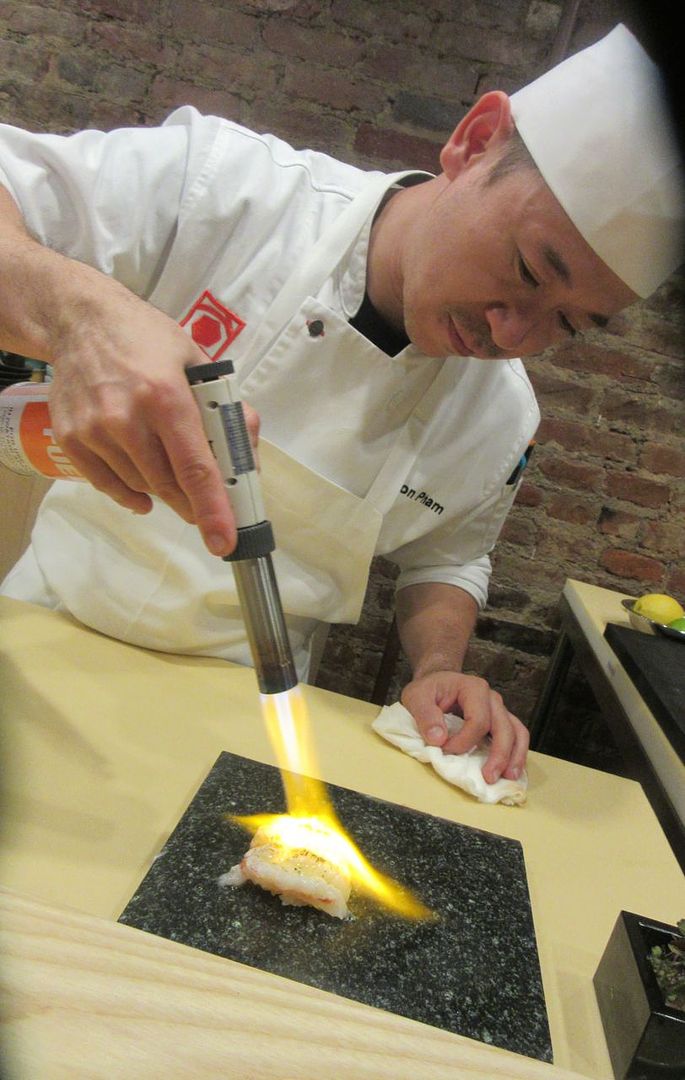
Now and then he torches to add variety in texture and temperature to his lineup.
I’m ready to be amazed. I like to eat sushi with my fingers. I put it whole into my mouth. The prettily seared morsel draped over its miniscule cushion of rice is soft, delicate, with crispy edges.
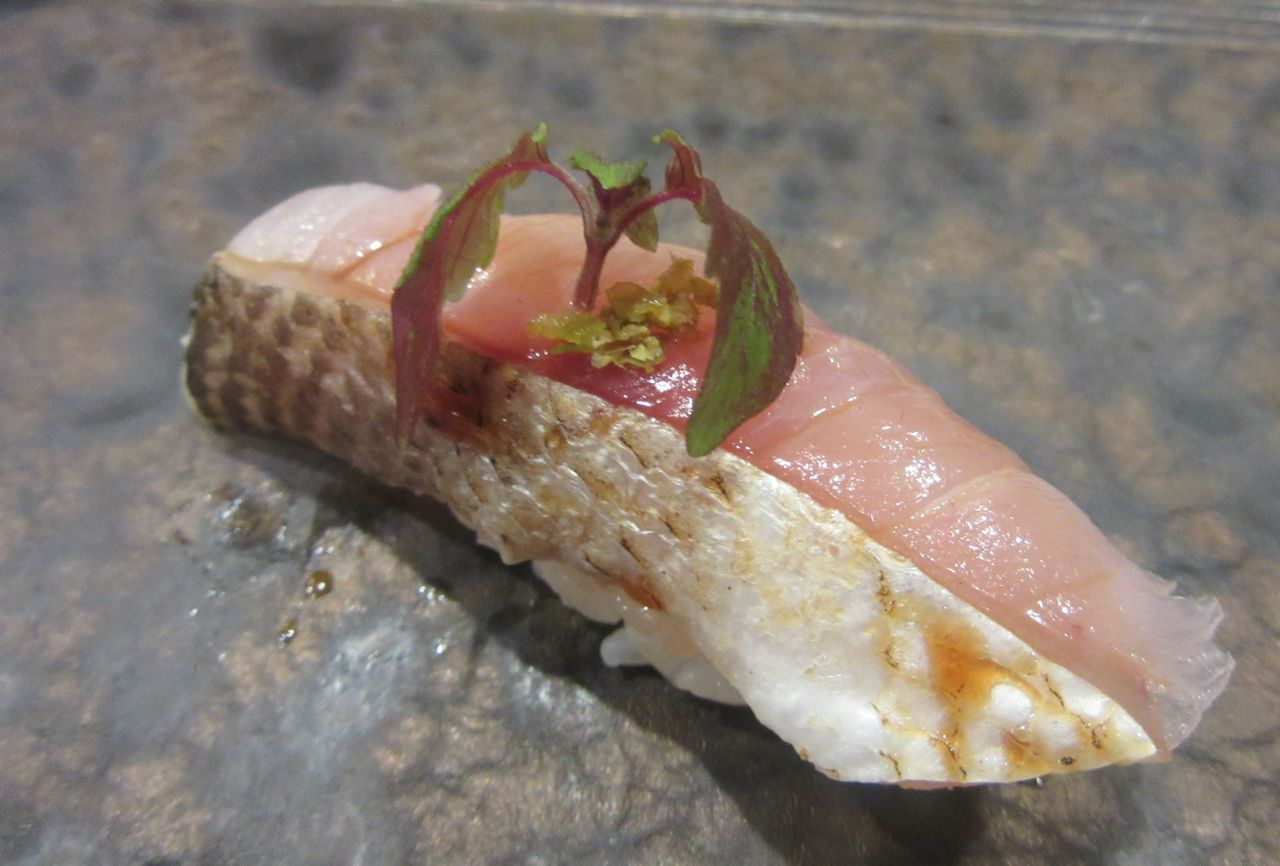
This creature is mild-tasting three-line Grunt caught wild in Chiba on Tokyo Bay.
Next comes Isaki with shiso,“three line Grunt, caught wild in Chiba,” the chef calls out. Pham’s workstation is right in front of us. I watch him cut thin slices from a giant scallop and sprinkle them with bamboo salt. “Giant sea scallop from Japan.” He holds up an everyday sea scallop and the imported giant to show us the difference.

He wants us to see the difference between everyday sea scallop and the giant creatures he gets from Japan.
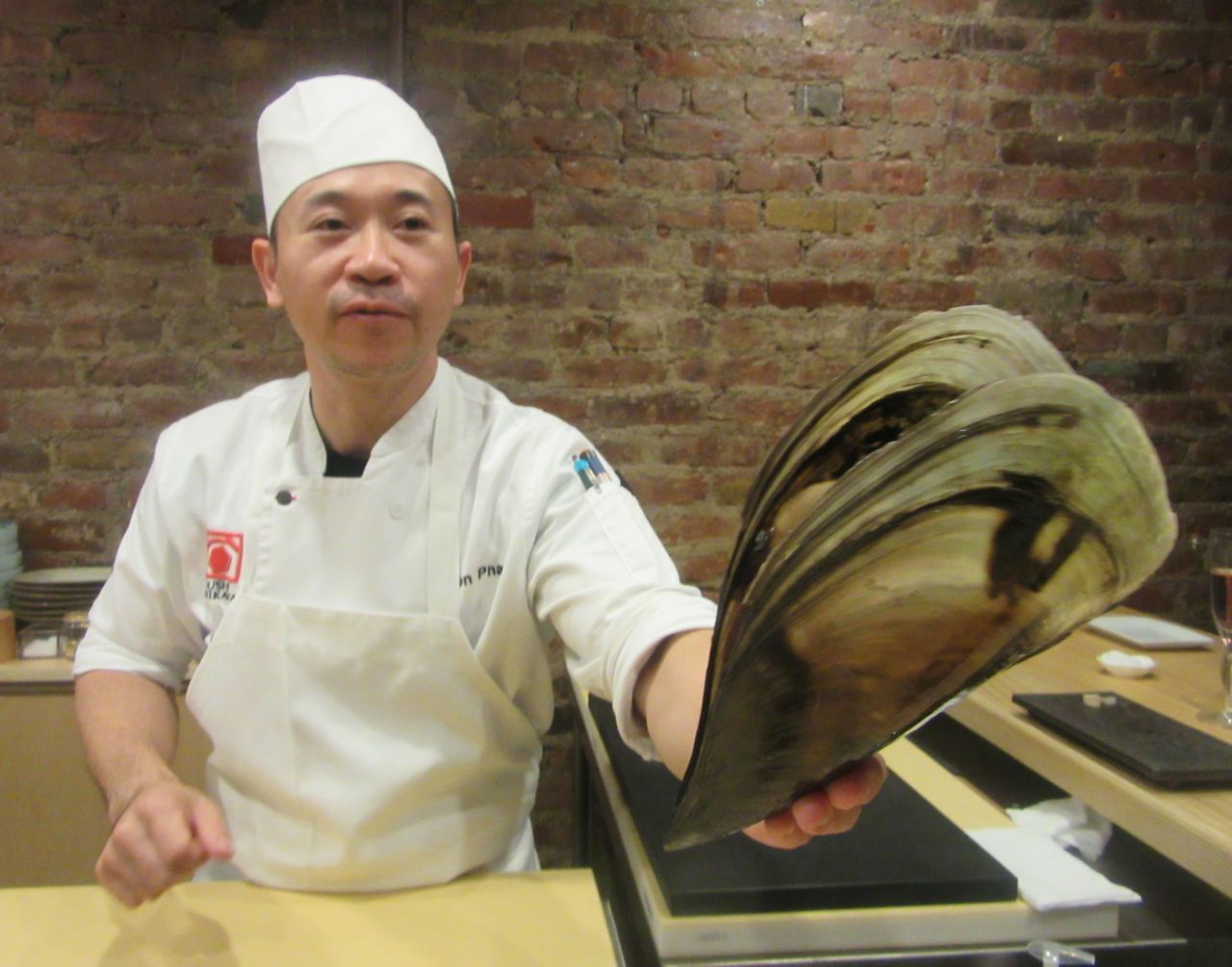
He sends a busser to fetch the giant scallop’s shell from the garbage. Agreed. I’ve never seen anything like it.
He sends a helper outside to fetch a shell from the garbage so we can see how the monsters arrive. At that point we are already eating black abalone with a disc of its liver on top. For some reason, it doesn’t have the usual mini taste explosion of fish liver.

Two kinds of raw shrimp on a tiny saddle of rice with grated bottarga on top makes us gasp.
But the next little morsel is a stunner: “Botan ebi (raw prawn) with shiraebi (white baby shrimp from Japan) and bottarga,” he says, holding up a chunk of pressed mullet roe as the source of the orange shavings on top. The silken shrimp fills my mouth, saltiness lingering. The two of us ummmm in unison and roll our eyes. Pham seems pleased.

A sliver of octopus from Hokkaido is topped with a suction cup and sprinkled with matcha.

The Japanese butterfish is pleated and topped with a baton of fresh ginger.
Octopus from Hokkaido with its extra-chewy little cups, sprinkled with matcha, is another textural mix with a flavor kick. Next he smears a sliver of Japanese Butterfish with buttery goo, torches again, and delivers one to each of us with a long baton of young Hawaiian ginger lying on top.
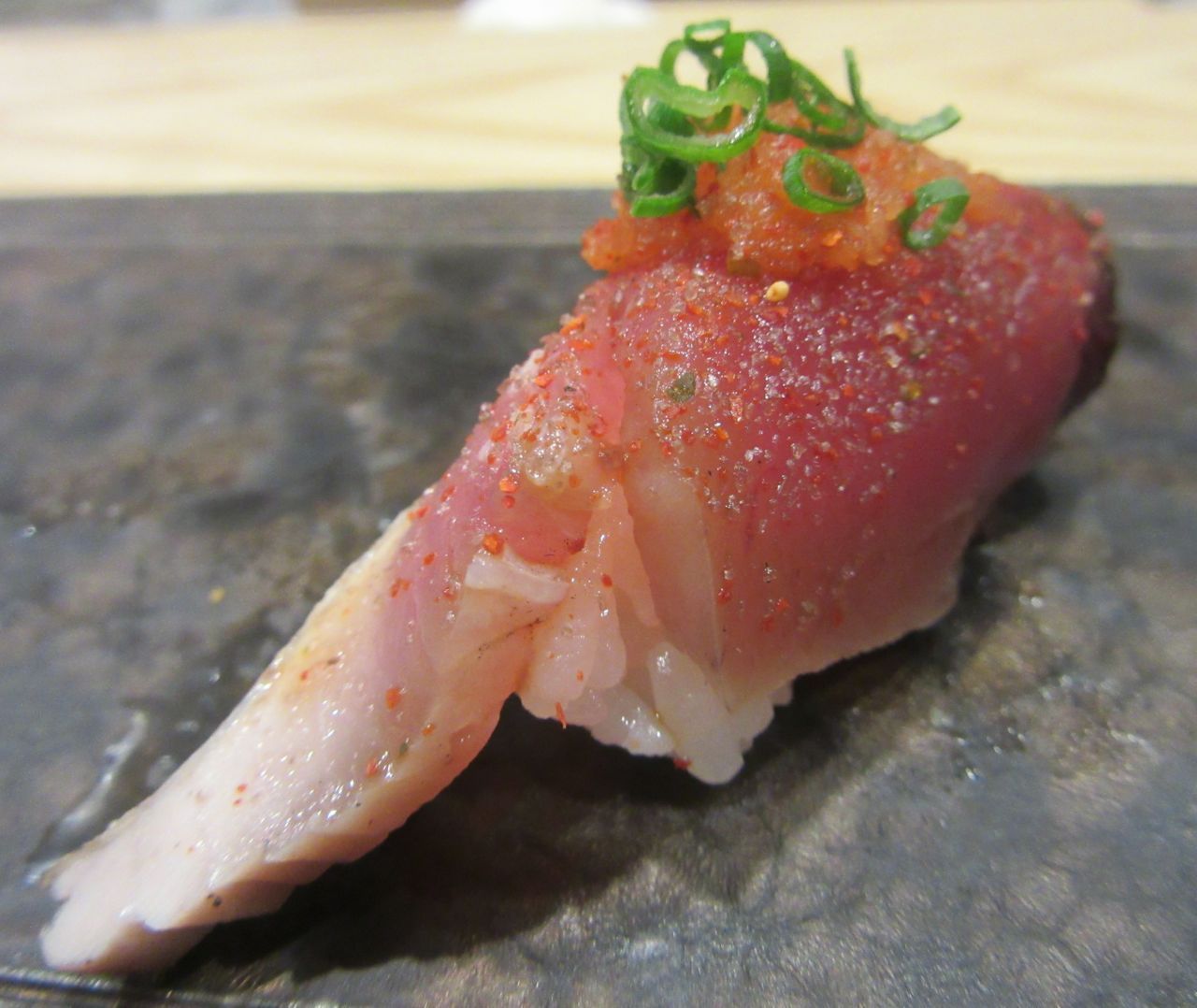
Pham pulls a messy little red side of fish from the keeper in the middle of his work space: hay-smoked bonito.

Cherry-blossom smoked Tasmanian ocean trout is topped with moromi miso.
From the fishkeeper he shares with his sous he pulls a deep red chunk and slices what looks like a small raw lamb chop – though, in fact it is hay-smoked bonito. The complexity is building. Moromi miso sits like sweet fruit preserves atop cherry-blossom-smoked Tasmanian ocean trout – a feast for the eyes, then the nose, then the mouth. I wonder if he often ad-libs. He has said he comes in every Monday to plan the menu for the week.
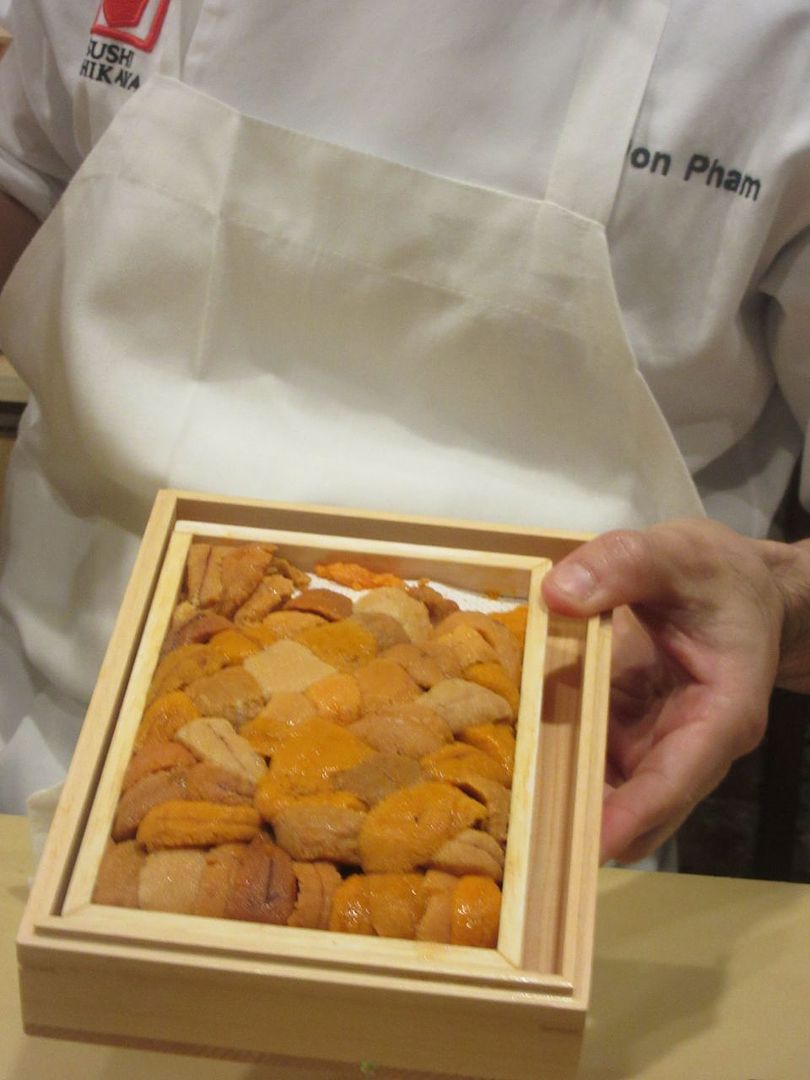
Tonight he has sushi from Russia and Chile and in this wooden crate: a collection from Hokkaido.
I open my eyes to see him pulling out boxes of sea urchin: uni from Hokkaido, Russia and Chile. I’ve never heard of uni from Russia, good enough reason to woo the Kremlin’s ambassador. Do you think Jared knows? Surely the investigative committee will understand. The uni riding its rice saddle gets gratings of black truffle. Intoxicating.

A collection of uni with grated black truffle ride on a tiny rice saddle. Pop it into your mouth and inhale.

Gold leaf waves from its caviar perch on top of tuna slivers at a climactic moment of the omakase.

I worry that the arrival of chawanmushi – as luscious as it is -- means the omakase is nearing its finale.
Then a pretty covered dish of chawanmushi arrives, seeming to signal the end of the seduction. Not that the custard isn’t properly delicate and lush with big chunks of seafood. Can it possibly be over so soon? I wonder.

The counter and tables are full. With omakase demands pressing, the chef does five at a time.
The place has filled. I watch Don Pham speeding up production. Working on a duo for us, then dispatching a quick trio to the three enthusiasts on our right, then fashioning a totally different duo for a young woman with her 14-year-old son to my left.

A chunk of tuna with sweet onion curls under a roof of black truffle.

In a coda of ambition, Shima-aji (striped jack) arrives with Chilean sea urchin.
Tuna with sweet onion curls and winter truffle is followed by shima-aji (striped jack) with Chilean uni. So it isn’t over. We’re getting a delicious coda. Major works of art. He paints kampachi with Vietnamese vinaigrette and adorns it with a tassel of Thai chili, Thai basil (from his backyard) and crispy shallot. “My father sends the basil seeds and the shallots from Vietnam,” he notes.

Don Pham’s father sends shallot seeds from Vietnam, shown here on kampachi with crispy shallots.

Another trio of uni on a cut of scallop with more osetra caviar sits in a sublime uni-miso sauce.
He delivers bowls with an uni trio and Osetra caviar on a slice of scallop in an uni-miso sauce. There are small wooden spoons to scrape up the last drops of the luxuriant sauce. The women watching alongside demand the same. I sense they are already into extra innings but determined to go on. I photograph one of them licking the bowl.

The trio of women next to us demand the same dish and one of them insists on licking the bowl.
What can I say about the melon? It’s a slim slice of perfect fruit, ripe and sweet, prettily cut, genteel. An organic heirloom from Weiser Farms in Bakersfield. And Pham serves it with yuzu sake in a small wooden cup. How inelegant of me to polish off the melon and sit there wondering if there’s an ice cream shop nearby. I occasionally get these attacks. A desperate need for sweet. That’s why I keep a supply of Jacques Torres’ dark chocolate bark in my fridge.

419 East 74th Street between First and York Avenues. 212 651 7292 Open Tuesday through Saturday. First seating at 5:30. Last seating at 9:30.
More BITES You Might Savor...
Save
Save
Save
Save
Save
Save